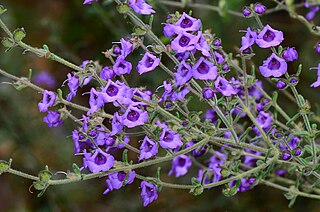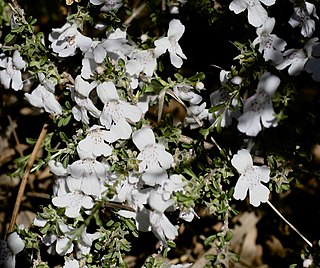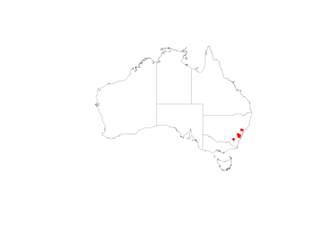
Prostanthera incisa, commonly known as cut-leaf mint-bush or native thyme, is a species of flowering plant in the family Lamiaceae and is endemic to south-eastern continental Australia. It is an erect, strongly aromatic, openly branched shrub with hairy, densely glandular branches, egg-shaped to oblong leaves, and pale mauve to mauve flowers.

Prostanthera calycina, the West Coast mintbush, limestone mintbush or red mintbush, is a species of flowering plant that is endemic to the Eyre Peninsula in South Australia. It is a small, more or less prostrate shrub with aromatic, elliptic to oblong leaves and red flowers.

Phebalium stenophyllum, commonly known as narrow-leaved phebalium, is a species of small shrub that is endemic to south-eastern Australia. It has scaly branchlets, narrow oblong to more or less cylindrical leaves and yellow flowers in umbels of three to ten.

Prostanthera ovalifolia, commonly known as the oval-leaf mintbush or purple mintbush, is a species of flowering plant in the family Lamiaceae and is endemic to south-eastern continental Australia. It is an erect shrub with egg-shaped leaves and groups of mauve to deep blue-purple flowers arranged in groups at the ends of branchlets.

Prostanthera nivea, commonly known as snowy mint-bush, is a species of flowering plant in the family Lamiaceae and is endemic to eastern Australia. It is a shrub with linear to cylindrical leaves and white flowers arranged in leaf axils near the ends of branchlets and is one of the mint-bushes that is not aromatic.

Persoonia confertiflora, commonly known as cluster-flower geebung, is a species of flowering plant in the family Proteaceae and is endemic to south-eastern Australia. It is an erect to low-lying shrub with hairy young branches, egg-shaped to narrow elliptic leaves, and hairy yellow flowers borne on leaf axils or on the ends of short branches.

Prostanthera cryptandroides is a species of flowering plant in the family Lamiaceae and is endemic to eastern Australia. It is a low, spreading shrub with narrow egg-shaped leaves and lilac to mauve flowers arranged singly in leaf axils.

Prostanthera stenophylla is a species of flowering plant in the family Lamiaceae and is endemic to Wollemi National Park in New South Wales. It is an erect, slender, aromatic shrub with hairy, oblong leaves and small groups of pale bluish mauve to violet flowers.

Olearia asterotricha, commonly known as rough daisy-bush, is a species of flowering plant in the family Asteraceae. A tall shrub with white, mauve or blue daisy like flowers growing from the Blue Mountains in New South Wales to western Victoria, Australia.

Cassinia tenuifolia, commonly known as bully bush or killmoke, is a species of flowering plant in the family Asteraceae and is endemic to Lord Howe Island. It is a dense, bushy shrub with hairy young stems, crowded linear leaves and sweetly scented flower heads arranged in corymbs.

Prostanthera hirtula, commonly known as hairy mintbush, is a species of flowering plant in the family Lamiaceae and is endemic to the south-eastern continental Australia. It is a strongly aromatic, densely hairy, spreading shrub with narrow egg-shaped leaves and dark mauve flowers, and that grows in exposed, rocky sites.

Prostanthera saxicola is a species of flowering plant in the family Lamiaceae and is endemic to eastern Australia. It is a shrub with linear to elliptic leaves and white to mauve flowers arranged in leaf axils.

Hemigenia scabra is an open, sprawling shrub with white flowers, hairy stems and foliage and is endemic to Western Australia.

Prostanthera baxteri is a species of flowering plant in the family Lamiaceae and is endemic to the south-east of Western Australia. It is an erect shrub with narrow egg-shaped to linear leaves and white flowers with a tinge of blue to pale mauve.

Prostanthera chlorantha, commonly known as green mintbush, is a species of flowering plant in the family Lamiaceae and is endemic to the south-east of South Australia. It is a small shrub with small, broadly egg-shaped to round leaves and mauve, bluish green, or greenish red to greenish yellow flowers with a pink tinge.

Olearia minor, is a small flowering shrub in the family Asteraceae. It has alternate leaves and white to pale mauve daisy-like flowers from winter to December. It grows in Western Australia, South Australia, New South Wales, and Victoria.

Prostanthera ringens, commonly known as gaping mint-bush, is a species of flowering plant in the family Lamiaceae and is endemic to eastern Australia. It is a bushy shrub with four-sided, hairy, densely glandular branches, oblong or egg-shaped leaves and pale blue to greenish or yellow flowers arranged singly in leaf axils.

Prostanthera rugosa is a species of flowering plant in the family Lamiaceae and is endemic to a restricted area of New South Wales. It is an openly-branched shrub with egg-shaped or narrow egg-shaped, thick, fleshy leaves and mauve flowers with a white tinge arranged in leaf axils near the ends of branchlets.

Pultenaea hispidula, commonly known as rusty bush-pea, is a species of flowering plant in the family Fabaceae and is endemic to south-eastern continental Australia. It is an erect, spreading shrub with many drooping branches, oblong to egg-shaped leaves with the narrower end towards the base, and yellow to pale orange and red flowers.

Bossiaea riparia, commonly known as river leafless bossiaea, is a species of flowering plant in the family Fabaceae and is endemic to south-eastern Australia. It is an erect or low-lying shrub with flattened branches, linear young cladodes, leaves mostly reduced to small scales, and yellow and red flowers.





















